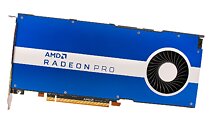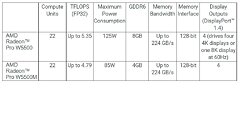Monday, February 10th 2020

AMD Introduces Radeon Pro W5500 Professional Graphics Card
AMD today announced the AMD Radeon Pro W5500 workstation graphics card, delivering the performance and advanced features demanded by today's Design & Manufacturing and Architecture, Engineering & Construction (AEC) professionals. AMD also announced the AMD Radeon Pro W5500M GPU, designed and optimized to power next-generation, high-performance professional mobile workstations. Today's design and engineering workforce pushes the boundaries of professional design applications. These increasingly mobile professionals often use multiple graphics-intensive applications simultaneously and require no-compromise performance to visualize, review and interact with their designs in real time.
AMD Radeon Pro W5500 graphics harness the high-performance, power-efficient AMD RDNA architecture, 7 nm process technology, high-speed GDDR6 memory, high-bandwidth PCI Express 4.0 support and advanced software features. Expanding the AMD family of high-performance professional graphics products, they offer outstanding performance in real-world applications, rock-solid stability and superb energy efficiency. In addition, the AMD Radeon Pro W5500 graphics card delivers incredible multitasking performance even in demanding situations, such as allowing professionals to continue developing their designs while rendering a visualization in the background."Designers and engineers require a professional graphics solution that delivers the performance and efficiency to meet today's unique challenges. Nothing is more stressful than a deadline, and AMD professional graphics keep performing when you need them most," said Scott Herkelman, corporate vice president and general manager, Radeon Technologies Group at AMD. "The AMD Radeon Pro W5500 graphics card delivers exceptional power efficiency and leadership performance for 2D and 3D design applications, enabling them to better visualize and interact with their designs in real time, explore new immersive workflows like virtual reality and maximize productivity."
The AMD Radeon Pro W5500 graphics card and the Radeon Pro W5500M GPU transform how project teams collaborate by enabling immersive, real-time visualizations of design concepts to make quick and better informed decisions. Key capabilities and features include:
The AMD Radeon Pro W5500 graphics card is expected to be available from leading retailers beginning mid-February 2020, for an SEP of $399 USD.
AMD Radeon Pro W5500 graphics harness the high-performance, power-efficient AMD RDNA architecture, 7 nm process technology, high-speed GDDR6 memory, high-bandwidth PCI Express 4.0 support and advanced software features. Expanding the AMD family of high-performance professional graphics products, they offer outstanding performance in real-world applications, rock-solid stability and superb energy efficiency. In addition, the AMD Radeon Pro W5500 graphics card delivers incredible multitasking performance even in demanding situations, such as allowing professionals to continue developing their designs while rendering a visualization in the background."Designers and engineers require a professional graphics solution that delivers the performance and efficiency to meet today's unique challenges. Nothing is more stressful than a deadline, and AMD professional graphics keep performing when you need them most," said Scott Herkelman, corporate vice president and general manager, Radeon Technologies Group at AMD. "The AMD Radeon Pro W5500 graphics card delivers exceptional power efficiency and leadership performance for 2D and 3D design applications, enabling them to better visualize and interact with their designs in real time, explore new immersive workflows like virtual reality and maximize productivity."
The AMD Radeon Pro W5500 graphics card and the Radeon Pro W5500M GPU transform how project teams collaborate by enabling immersive, real-time visualizations of design concepts to make quick and better informed decisions. Key capabilities and features include:
- High-Performance AMD RDNA Architecture - Features a redesigned geometry engine and compute units, delivering up to 25 percent higher performance-per-clock than the previous-generation Graphics Core Next (GCN) architecture.
- Incredible Multitasking Performance - The AMD Radeon Pro W5500 graphics card delivers outstanding multitasking performance even in demanding situations, offering up to 10x better estimated application workflow performance than the competition in the SPECviewperf 13 benchmark under a multitasking load.
- Real-World Power Efficiency - The combination of the power efficient AMD RDNA architecture and Radeon Pro Software for Enterprise's intelligent power management technology enable the AMD Radeon Pro W5500 graphics card to precisely scale to meet the power demands of professional applications. As a result, it consumes up to 32 percent less system power on average in SOLIDWORKS solid modeling workflows than the competition.
- Professional-Grade Software - Radeon Pro Software for Enterprise offers performance improvements in each release and is optimized for demanding 24/7 computing environments, with extensive OEM platform and ISV certification testing to deliver the quality professionals demand. The latest driver (20.Q1) achieves up to an estimated 15 percent faster geomean score in the SPECviewperf 13 benchmark than version 19.Q1 from 20194.
- AMD Remote Workstation - Allows professionals to access their physical workstations from virtually anywhere with rich graphics experiences using Citrix Virtual Apps and Desktops or Microsoft Remote Desktop.
The AMD Radeon Pro W5500 graphics card is expected to be available from leading retailers beginning mid-February 2020, for an SEP of $399 USD.


23 Comments on AMD Introduces Radeon Pro W5500 Professional Graphics Card
All that silly marketing gibberish, and very little hard facts about the actual real world performance, nor any benchmarking results....
And with only 8GB of vram, these cards can't really offer much over the current/last models in terms of increased productivity or process flow... so can someone please tell me exactly why would I want to run out & buy it ??
f.A.i.L....
The card will become available, people will buy it, use it and we'll see how good it is. But it doesn't matter that much. If you need a pro card, you buy it. That's it. There are no AIB variants, so it's not like you have a choice (other than Nvidia vs AMD).If you have a last gen product, keep using it. What's the matter with you?
It's a pro card. Most of them will be sold in OEM workstations, not alone (as upgrades).
As for direct comparison: W5500 can be seen as a slightly slower successor to WX7100, but for a lot less.
WX7100 launched at AFAIR $600, it's $500-540 today. W5500 launches at $400.
Both cards are on offer, which basically means that AMD increased production capacity (since they're made by different contractors, using different process).
It's great for Photoshop CC clusters. It's also one of the options for the new Mac Pro.
A friend uses these cards when modeling power station layouts, and the software then provides BOM lists to get quotes from suppliers, as well as running build simulations ensuring there aren't any design issues.
Their data is usually less than 2Gb but when they run the simulation it can use 6Gb as it runs and builds reports.
They use these cards, but not for gaming. I also know seismic modelling for oil and gas exploration use these pro cards and don't need 32Gb of memory. They need faster memory as it's highly parallel, but there are a lot of dependancies.
SketchUp used to be Google but got bought by Trimble (I do work for them), and many other softwares used require pro grade math performance. Not rounded by consumer grade drivers, not handicapped by consumer grade hardware.
Any more derogatory comments directed at other members will earn a weeks vacation. Fair warning to everyone.
Once they've determined the needs, they also calculate any potential costs. This gets green-lighted by the CFO, of course handling the budget.
Once the costs are done, it's time for those companies to attempt to showcase whatever they got and strike deals. As an example, the SEP for the W5500 above is $399, but in a bulk of 20 it would probably end up at $325 depending on the contract negotiated.
So 4 workstations during high demand could save 30 minutes per day not waiting on hardware, meaning during high profit times 2 hours more work could be accomplished, the low cost of 1K for a upgrade is pennies of cost during those times.
Would be a similar thing to when NVidia made the GTX 560-448, using "Defective" cores that coudn't be used in the 570 or 580 cards of the day.
BTW I bought one of those - Still works great to this day.
This is an RDNA card based on a Navi variant (Navi 14? w/e is in the rx 5500 I believe). Radeon VII is Vega based, not RDNA...though both are 7nm. The nvidia example is same generation gpu (fermi).
That is a big card like the Rad VII, no doubt.
Someone definitely don't know whom this card is for ;)